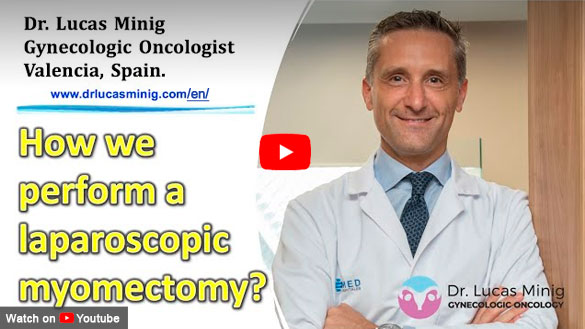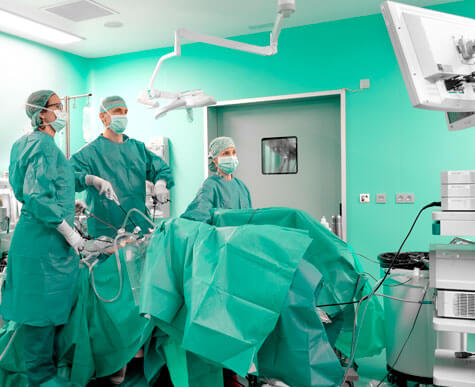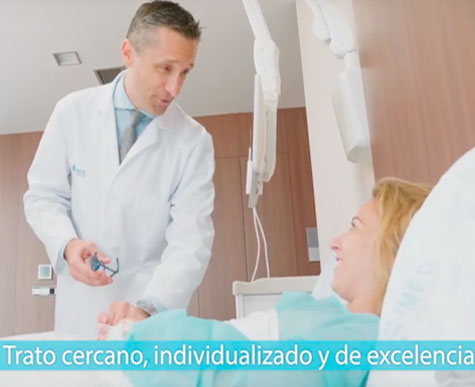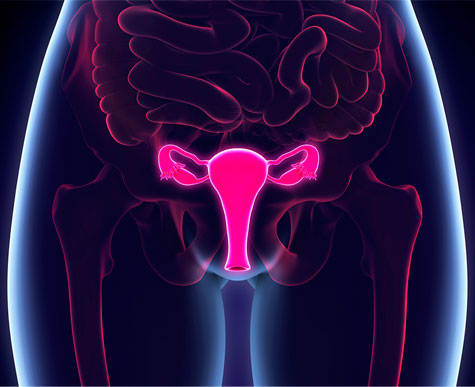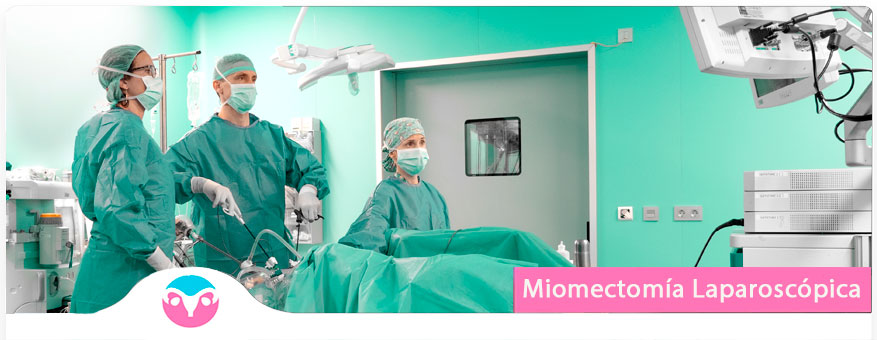
About Laparoscopic Myomectomy Surgery for Uterine Myomas & Fibroids
The main treatment to perform the operation of fibroids in the uterus is based mainly on laparoscopic myomectomy for the removal of uterine fibroids from the patient.
This fibroid surgery is minimally invasive, which makes it possible to alleviate the symptoms associated with these benign tumors without the need to carry out an open operation, as is the case with abdominal myomectomy.
Fibroids surgery is performed by the specialist in the treatment of uterine fibroids in Valencia, Spain, Dr. Lucas Minig.
Request a quick appointment with the specialist in Laparoscopic Myomectomy, Dr. Lucas Minig, an expert Gynecologist Oncologist in this type of cancer that is very common in women.
Appointment: Click to Request an Appointment for ovarian cancer in Spain.
Contact: +34 679 112 179
What is a laparoscopic myomectomy?
It means that the myomectomy, or surgical removal of the fibroid(s), is performed by laparoscopic or robotic minimally invasive surgery.
The uterus is made up of two parts: the cervix and the uterine body. Uterine myomas or fibroids are benign tumors in almost 100% of cases that originate from the walls of the uterus. They can be single or multiple and can have a very variable size depending on each case.
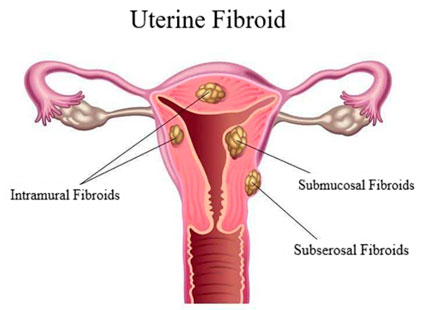
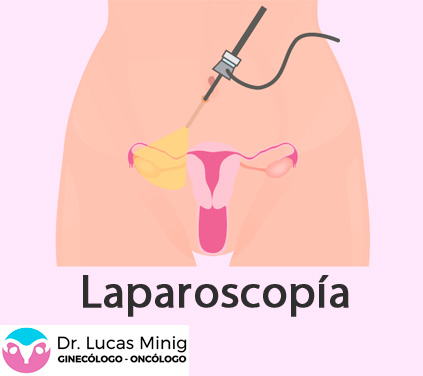
How is a laparoscopic myomectomy done?
Procedure to perform a laparoscopic myomectomy
The surgeon makes a small incision at or near the navel. Then, a laparoscope (a thin tube equipped with a camera) is placed into your abdomen. The surgeon performs the surgery with instruments placed through other small incisions in the wall of the abdomen.
Are you looking for a specialist to do a Laparoscopic Myomectomy?
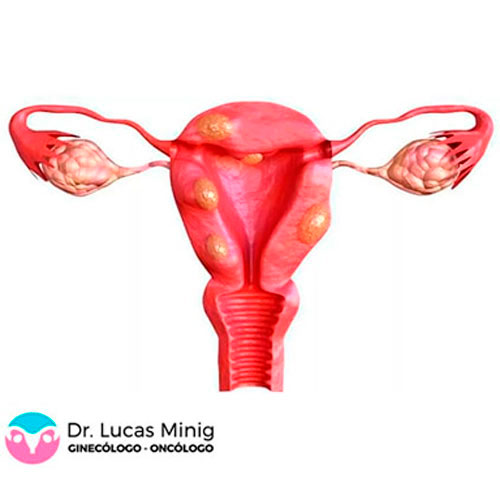
What are the indications for performing a laparoscopic myomectomy?
The indication to perform a myomectomy depends on several factors:
How long does it take to perform a laparoscopic myomectomy?
The duration of a laparoscopic myomectomy usually varies depending on the number and size of the fibroids to be removed. In general terms, the average time is usually 90-120 minutes depending on the location of the fibroids, with the surgical time being shorter for fibroids with a subserosal component and longer for fibroids with a submucosal and intramural component.
In all cases, patients require general anesthesia to perform this procedure.
Uterine Myoma Operation
How is uterine Fibroids removed?: Uterine Surgery
It can be done in two ways: surgical and non-surgical removal.
– Surgical removal (myomectomy). There are several ways of approaches depending on the location and size:
- Hysteroscopy (through vagina and cervix).
- Laparoscopy (minimally invasive surgery, with 3-4 small 1 cm incisions made in the abdomen).
- Open surgery (cesarean section or median longitudinal incision).
– Non-surgical treatment (embolization). The treatment of uterine fibroids without surgery is possible thanks to a process called embolization; Necrosis of the fibroid is induced, without surgery, by blocking the blood vessels that nourish it. This type of treatment is less used, due to the inability to obtain tissue for biopsy.
How long do I have to be hospitalized after a laparoscopic myomectomy?
Normally, in the absence of postoperative complications, the hospitalization time is usually one day. In some cases, however, patients can be discharged on the same day as surgery.
During admission, all patients will be seen by Dr. Minig to monitor their recovery until discharge from the hospital.

Is movement restriction necessary after surgery?
Currently, there is no scientific evidence that restricting movement after laparoscopic hysterectomy increases the possibility of postoperative complications.
In this way, patients can go back to their daily activities and the usual movements that they made before surgery progressively, as long as the pain allows it.
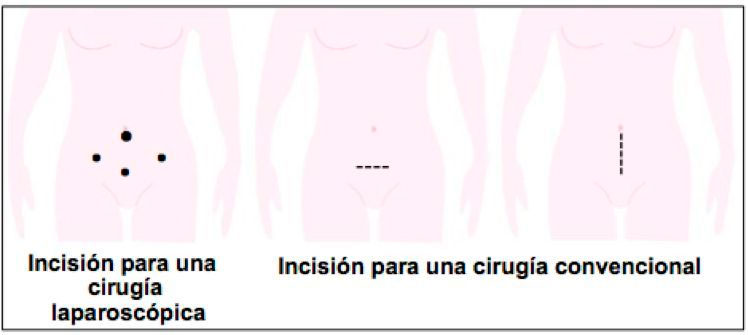
How long do you have to wait to try to get pregnant after a myomectomy?
Because myomectomy creates a scar on the uterus, it must heal properly. This will reduce the risk of uterine rupture in a future pregnancy. Thus, it is usually recommended to start with the search for pregnancy 4 months after surgery.
Laparoscopic myomectomy is the surgical intervention used to remove uterine fibroids.
What is the recovery like after a laparoscopic myomectomy?
Because the procedure is performed through small holes in the abdominal region, recovery from laparoscopic myomectomy is usually short, and patients are often able to return to their daily lives in a very short period.
Other advantages of this type of intervention are:
It is not recommended for large fibroids or multiple fibroids. Not everyone is qualified to perform it, and they must go to centers and professionals trained and experienced in minimally invasive surgery.
How long does it take for the uterus to heal after a myomectomy?
Once the laparoscopic myomectomy procedure is done you will begin to feel better and stronger each day in the recovery process, you may tire quickly and need analgesics (pain medication) for a week or two. You may need 4-6 weeks to fully recover.
What happens after a myomectomy?
After a myomectomy, most women experience relief from bothersome signs and symptoms, such as heavy menstrual bleeding, pelvic pain, and pressure. Improvement infertility
How to care for surgical wounds after surgery?
The testimony of Rocío, operated on laparoscopic myomectomy.Request a consultation with the Gynecologist
Frequently asked questions about Laparoscopic Myomectomy
What type of anesthesia is used for a myomectomy?
General anesthesia is used for laparoscopic myomectomy and generally for abdominal myomectomy; it is also sometimes used for hysteroscopic myomectomy.
Laparoscopic use
The surgeon makes a small incision at or near the navel. Then, a laparoscope (a thin tube equipped with a camera) is placed into your abdomen. The surgeon performs the Laparoscopic Myomectomy surgery with instruments placed through other small incisions in the wall of the abdomen.
How is the postoperative period of a myomectomy?
Postoperative at home after laparoscopic myomectomy: The patient can move and return to their activities without making great efforts. In general, the recovery can be between one or two days. Sexual intercourse will be resumed when the doctor indicates it.
How long does it take for the uterus to heal after a myomectomy?
After a laparoscopic myomectomy, a waiting time of 3 to 6 months is advised before attempting conception to allow the uterus to fully recover.
What exercises can I do after a myomectomy?
In general, it is advised to rest for approximately 1 month after surgery with Doctor Lucas Mining for Laparoscopic Myomectomy, the patient will be able to walk on flat ground without problem, however, it is not advisable to perform exercises such as abdominal exercises or exercises that increase abdominal pressure to avoid navel problems.
How to deflate the belly after a laparoscopy?
Eat slowly, chewing food correctly. Avoid foods that cause flatulence (dairy products, legumes, broccoli, cauliflower…). Walk from time to time so that the gases disappear.
Related Common Terms
Here are some of the terms that our patients frequently search for.
Myomas Laparoscopy. Laparoscopic myomectomy. Laparoscopic myomectomy. Laparoscopy Myoma 12 cm or another size. Laparoscopy large fibroids. Laparoscopy uterine fibroids recovery. Laparoscopic uterine myomectomy. Myomectomy treatment with Doctor Lucas Mining in Valencia, Spain. Myomectomy operation. Know all the information and costs about the Laparoscopic Myomectomy Price.
Patient Testimonials – Laparoscopic myomectomy.
Doctor Lucas Minig Specialist in Laparoscopic Surgery in Valencia, Spain
Contact Us
Leave us your data and consultation to offer you personalized medical advice
International Consultation
If you want remote medical care, you can consult
through the following links:
International Appointment
Online Consultation
Whatsapp: + 34 679 112 179

